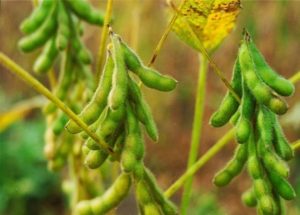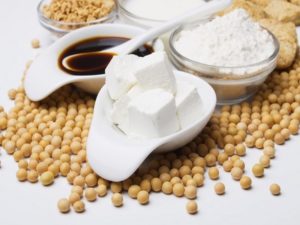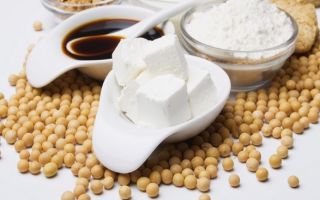Content
- 1 What does soya look like and where does it grow?
- 2 Composition and nutritional value of soybeans
- 3 What is soy good for the body
- 4 Soy during pregnancy and breastfeeding
- 5 Is soy good for children?
- 6 Soy for weight loss
- 7 Soy in sports nutrition
- 8 Soy products
- 9 The benefits of sprouted soybeans
- 10 Roasted soy
- 11 Why soy is harmful
- 12 Why genetically modified soybeans are dangerous
- 13 How to choose and store soybeans
- 14 Conclusion
Soy belongs to the genus of plants in the legume family. Its fruits are called soybeans - they began to be grown in China, and in Russia, their fashion as a food product spread from France in the 18th century. Despite the fact that the plant has been cultivated for more than three thousand years, the properties, benefits and harms of soy are the topic of discussion in modern dietetics.
What does soya look like and where does it grow?
Soy is an annual plant with pubescent leaves, taproot, small flowers, bean-shaped fruit. The height depends on the variety and varies from 25 cm to 200 cm. Soybeans are grown in America, Australia, Southern Europe, Asia. On the territory of Russia, the bulk of the sown area is located in the Kuban and the Far East.

Composition and nutritional value of soybeans
The plant has become popular in vegetarian diets thanks to soy protein, which has the benefit of being a substitute for meat and dairy products. The calorie content of 100 g of beans is 446 kcal. As part (in g):
- carbohydrates - 30.16;
- fats - 19.94;
- proteins - 36.49;
- water - 8.54;
- ash - 4.87.
The benefits of soybeans, their properties are explained by the chemical composition:
- vitamins - B, C, E, K, D, PP;
- macroelements - potassium, calcium, silicon, chlorine, phosphorus, magnesium, sulfur;
- trace elements - iron, manganese, boron, aluminum.

What is soy good for the body
Vitamins A and E contained in beans have antioxidant properties, neutralize the harm of toxins. The use of B vitamins is to improve metabolism, the work of all organs. Lecithin is especially important for losing weight: it accelerates metabolism, reduces the level of "bad" cholesterol. The bile ducts are cleared thanks to phospholipids, triglycerides are a source of energy for humans. Isoflavones prevent the formation of cancer cells, tocopherol has the ability to strengthen the immune system, fight aging. The beneficial properties of soy reduce the risk of diabetes, cardiovascular pathologies, liver disease, and allergy to animal protein.
For men
At the end of the last century, studies were carried out at Harvard, but scientists still argue about the benefits and harms of soy for men's health and cannot come to a consensus. It is assumed that when beans are consumed, testosterone decreases, hormonal balance and sexual function are disturbed, and fewer sperm are produced. But in practice, a large amount of protein increases sperm volume, while the number of sperm does not change, only their concentration nominally decreases.
It has been proven that vitamin E is directly involved in the formation of male semen, and with its deficiency, the vessels and the nervous system are affected. It helps prevent prostatitis, heart attack, neurosis - these diseases have become common in men. The benefits of soy for men are observed with moderate use. Doctors recommend the daily inclusion of the product in the diet in the amount of 20 g, there is no harm from its use, and the risk of atherosclerosis and heart attack is significantly reduced.
For women
As a result of research and practical observation, the benefits of soy for women have been proven.During menopause, hormone therapy may be replaced with soybeans to maintain estrogen levels. 100 g of the product contains the daily norm of isoflavones necessary to adjust the hormonal background. They have properties to overcome premenstrual syndrome, unpleasant symptoms during menopause. The use of soy prevents the development of breast cancer and osteoporosis. Lecithin, which is part of the beans, prevents the accumulation of fat in the liver, helps to normalize weight.
Soy during pregnancy and breastfeeding
It is believed that the health benefits of soy for a woman during pregnancy are completely absent and the product is even harmful. The statement is incorrect, because due to the high protein content of the beans, the fruit fully develops. The properties of lecithin allow the normal intrauterine formation of the baby's nervous system, iron promotes hematopoiesis.
The peoples of the USA, Europe, Asia use soy for food during pregnancy, while complications, deviations were not noticed. To get the benefits, soy beans should be consumed in moderation: 1 to 2 cups of soy milk per day is enough.
During breastfeeding, it is necessary to take a responsible attitude to the introduction of a new product into the diet. If, after trial use (no more than one teaspoon), the baby does not have a reaction in the form of diarrhea, rashes, then there are no prohibitions on use. The quantity can be gradually increased. During the period of breastfeeding, the daily rate is 60 g, twice a week. With this approach, the woman and the baby only benefit from soy products. A consultation with a doctor is necessary.
Is soy good for children?
It is worth finding out whether soy should be included in the children's diet, the product brings benefits or harm to the child's body.
Beans, which contain complete protein and oil, promote the growth of the body, activate metabolism, and form the skeleton. Healthy mixtures are produced for children under one year old with soy. They have anti-allergenic properties, include the entire complex of essential vitamins and minerals. Recommended for cow's milk intolerance. The mixture should be introduced gradually, over the course of a week, in consultation with the pediatrician.
Soy products also have a beneficial effect for infections accompanied by diarrhea. The stool quickly returns to normal. Despite the medicinal properties of soybeans, in some cases you should refrain from using it:
- with congenital hypothyroidism;
- premature babies;
- hypotrophy.

Soy for weight loss
Despite the high calorie content of the product, the soy diet is effective. This is due to the high content of lecithin, which has a choleretic effect, in beans, which can lower cholesterol and reduce appetite. With cellulite, soy sprouts should be introduced into the diet, the benefit of which lies in their ability to renew skin cells, eliminate flabbiness, and make it elastic.
Due to the complete absence of fats in the composition of soybeans, dishes from it are obtained dietary. Meat, milk, cheese, butter, cottage cheese and other soy products are used for their preparation. Season vegetables and cereals with a sauce or bean paste.
The protein, which is abundant in the plant, is remarkably absorbed, strengthening the muscles. But you shouldn't forget about regular physical activity.
Due to phytoestrogens, analogs of female hormones, the soy diet is contraindicated:
- with violations of the thyroid gland;
- during pregnancy;
- adolescent girls.
Soy in sports nutrition
Despite controversy about the benefits and dangers of soy products, the protein derived from the plant's beans is the mainstay of sports nutrition. It is important for those involved in bodybuilding, fitness. Soy isolate is used as a protein source, which supplies amino acids to cells and gives them energy. The protein-rich dietary supplement can be taken diluted with water or juice. In this case, it is important to adhere to the dosage, the manufacturer's instructions.Otherwise, the benefits of soy protein will be completely leveled, an overdose will harm the digestive organs.
Protein is consumed an hour before or after training. This is necessary to nourish the muscles of an athlete experiencing heavy loads. A doctor's consultation is required.

Soy products
Soy is found in most foods. It is included in semi-finished products, sausage, confectionery, milk, and baby cereals. In addition to low soy products, there is an assortment made directly from beans:
- flour - the base of meat and noodles, made by grinding the grains;
- oil - obtained by the method of extraction from soybeans, serves as the basis for margarine;
- milk - a product for babies, which is created by soaking and grinding beans;
- sauce - enhances the taste of dishes, it is produced by splitting starch;
- tofu cheese - used as cottage cheese.
The benefits of sprouted soybeans
Soybean sprouts are easy to obtain at home from beans. This will take no more than a week. They are ready when they reach a length of 4 cm. If we compare the benefits and harms of sprouted soybeans, the percentage is 100: 1. A contraindication is an allergy to the product. Among the useful components of sprouts:
- amino acids;
- cellulose;
- microelements,
- vitamins,
- choline,
- lecithin.
The benefits of soybean sprouts for children, the elderly, women during pregnancy and lactation cannot be overstated. They are not recommended to be eaten raw, but after blanching for 5 minutes. Bean sprouts allow you to:
- cleanse blood vessels;
- improve sleep;
- strengthen the nervous system;
- free the liver, intestines from toxins;
- improve memory;
- restore brain cells.
Since the calorie content of sprouts is only 30 kcal per 100 g of product, their beneficial properties can be used during a diet.

Roasted soy
Many people prefer roasted soybeans, the benefits of which are slightly reduced after cooking, but the taste is brighter with the help of spices and sauces. The beans are pre-soaked for 10 hours, then dried. Fried with a little oil, salt and spices until browned. The option of frying in the microwave or in the oven is possible.
Why soy is harmful
There is no single point of view among scientists about the harm of soybeans. Among the unsupported scientific arguments:
- the use of beans contributes to a decrease in the brain, the development of Alzheimer's disease;
- acceleration of aging;
- complication of pregnancy;
- and is also contraindicated in children;
After testing, no harm of the product to the human body was revealed. It has also been established that many of the positive properties are overly exaggerated. However, the benefits of soy protein for men, women and children are clear.

Why genetically modified soybeans are dangerous
Scientists have created beans with altered DNA for resistance to extreme weather conditions, diseases, pests. To this end, they add or subtract the appropriate genes in soy. The consequences of the use of such products by people have not yet been studied. Experiments were carried out on animals, which ended in a number of cases with the detection of gastrointestinal inflammation, cancer, and immunity disorders.
Genetic modification of soybeans is a way to increase crop yields in order to provide the growing population of the world with food. Supporters of GMO harmlessness argue that 20 years of using soy products have not harmed humans. At least this is not reflected in the WHO reports.
How to choose and store soybeans
Buying soybeans by weight or in transparent packaging will allow you to consider and evaluate the quality of the product:
- there should be no litter in the package;
- the shape of the beans is round or oval;
- the grains are dry, not damaged;
- the surface is smooth;
- beans are moderately hard;
- the label must contain information about the manufacturer, expiration date, storage conditions.
Experts recommend preparing dishes from light-colored soybeans: dark is considered fodder. Store the product in a dry, dark place at room temperature in a cloth bag. You should not mix the beans you have just bought with those you have already purchased. The maximum storage time is 1 year at a humidity not exceeding 14%. After the expiration date, the product cannot be used.
Conclusion
The benefits and harms of soy are determined by the quality of the product, the state of human health, as well as the preferences and frequency of use. With proper use, moderate use, careful attention to the choice of beans, the effect of their use will not disappoint, and their beneficial properties will fully manifest themselves.

